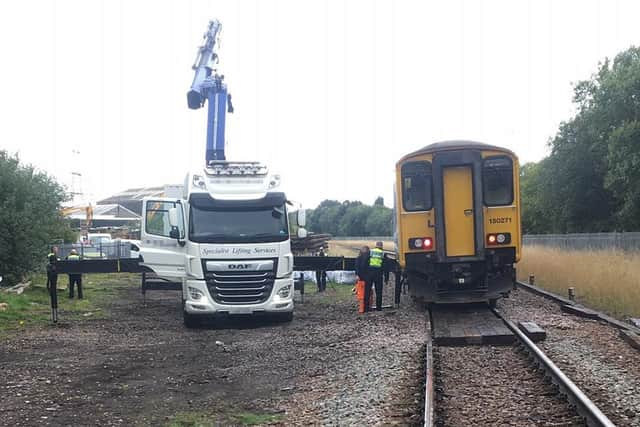Driver of lorry collecting portable toilets near Yorkshire railway station struck Northern train because he didn't think line was open
The Rail Accident Investigation Branch has today released a safety digest report into the incident involving a Northern service from Huddersfield to Sheffield on August 27.
The train had just left Penistone Station and was accelerating up to 27mph when it struck the stabiliser leg of the lorry, which was parked next to the track, shortly before 9am.


Advertisement
Hide AdAdvertisement
Hide AdAt the time, the lorry's legs were deployed as its crane was being used to remove portable toilets from the lineside site following the completion of engineering work.
The train driver saw the lorry and its driver but did not notice the leg until a few seconds before the collision.
The 25 passengers and the train crew were not injured, though there was some damage to the train.
The RAIB found that track renewal work arranged by Network Rail in conjunction with three contractors had been taking place at Penistone for most of August. A further contractor had been engaged to provide two portable toilets for workers' use, and the delivery and collection of them was sub-contracted to a haulage company.
Advertisement
Hide AdAdvertisement
Hide AdThe report states: "The haulage company’s lorry driver parked near to the access gate for the site at 08:32am. He met a member of staff who had been asked to let the lorry into the site. Once they had confirmed the lorry was in the right place, the driver drove into the site through the open gates and parked it in a position to lift the portable toilet units onto the lorry’s flatbed. He then deployed the stabiliser legs in readiness to use the lorry’s crane. The lorry driver had already loaded the first unit onto the lorry and was just lowering the second one when the train approached and struck the lorry’s front, nearside stabiliser leg.
"The lorry driver did not consider how close the stabiliser leg was to the nearest running line when he positioned the lorry and set it up for the lifting operation. Measurements and witness marks on the ground indicate the base of the stabiliser leg was at the end of the sleepers, about 0.5 metres from the nearest rail. The lorry driver had no experience of working next to an open railway line and thought that no trains were running because he had been let straight into the site by the member of staff. The lorry driver had not confirmed his understanding that no trains were running.
"The member of staff was a key holder for the access gate to the site. He had been asked on the previous evening, to go to the site at 07:45am and was only told to open the gate and allow the lorry into the site to collect the portable toilet units. He was standing next to the access gate when the train approached and had not realised that the stabiliser leg was too close to the nearest running line.
"If work is taking place within the railway boundary fence, but is more than three metres from the nearest running line, and can be seen by the driver of an approaching train, then the railway Rule Book defines this as being on the ‘lineside'. If work is taking place closer than three metres from the nearest running line, then the Rule Book defines this as being ‘on or near the line’.
Advertisement
Hide AdAdvertisement
Hide Ad"The position where the lorry had been parked to lift the units meant that it was on or near the line. The Rule Book requires a controller of site safety to be present before a road vehicle can go on or near the line, but, while the member of staff held a personal track safety competency, no one who held the COSS competency was present on this occasion. The Rule Book also states that no part of a road vehicle should be allowed within two metres of any line on which a train might approach. In this case, however, one of the lorry’s stabiliser legs was much closer than two metres and was in fact foul of the nearest running line.
"The contractor who provided the portable toilet units had a generic method statement and lifting plan for collecting the units. The method statement included a hazard analysis section, with a checklist of hazards to consider. It also included a risk assessment for the identified hazards, with each hazard given a risk score (its likelihood multiplied by its severity) and a control measure to reduce the risk. ‘Railways’ was included as a possible entry in the hazard checklist, but it had not been selected for the work on 27 August. This meant that the contractor did not carry out a risk assessment for working near to a railway line. The method statement made no other mention of working near to railways and did not specify what levels of supervision, experience or competence would be required."
